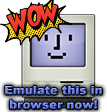At one time, a Mac graphics program was judged by its feature count: SuperPaint, with a drawing (object-oriented) layer, was thought superior to MacPaint; PixelPaint, with color, was even better; PixelPaint Professional, with 32-bit color, was better yet. But nowadays, just counting features has become unpopular among some people. Better to write a program that does one thing well, the reasoning goes, than to write a mediocre program purporting to be an all-in-one solution.
What, then, should you make of UltraPaint? In its design, feature count was clearly paramount. UltraPaint offers many more black-and-white paint features than SuperPaint, almost all of PixelPaint’s color tools, a superset of MacDraw II's object-oriented features, and the gray-scale prowess of Digital Darkroom. All this comes in a single program for less than half the price of PixelPaint or Digital Darkroom.
Layers and Icons
Imagine that you can superimpose three Macintosh windows. In the first, you’re running PixelPaint, where you can create 256-color paintings with stunning graduated fills, fancy special effects, and sophisticated color palettes. In the next window (superimposed on the first) you’re running MacDraw, an object-oriented program offering laser-quality text, commands for grouping and aligning, and an extensive ruler-and-grid system. Finally, in a third window, imagine Canvas, an object-oriented program that lets you use painting features (spray can or paintbrush) to shade the MacDrawtype objects you create.
That’s the principle of UltraPaint — drawing and painting together. Each type of graphic — Painting, Drawing, and Composite — is a separate layer; you see through them as though they were on sheets of acetate. Tiiere’s only one Painting layer — the back layer — but you can superimpose up to seven Drawing or Composite layers on it in any order. Surrounding the graphics window are floating palettes containing colors, patterns, tools, and so on.
Now things get complicated. In order to cram these hundreds of features into UltraPaint, the developers have hidden each tool’s settings and options behind its palette icon. Sometimes clicking on an icon springs a pop-up menu; sometimes a dialog box appears when the tool is doubleclicked. Tiny icons-within-icons on the palettes hint as to whether you should click for a pop-up, double-click for a dialog box, or both. There’s no question: UltraPaint is no match for MacPaint in simplicity.
Swiss Army Knife
There is, however, a silver lining. For every tool that’s been complicated by feature-mania, UltraPaint’s technology makes other aspects of the Mac artist’s life easier. Primary among these advantages is the fact that UltraPaint regally is an all-in-one program: you don’t have to know whether the file you’re opening is a MacPaint, PICT, PICT2, TIFF, or MacDraw file. Indeed, you don’t even have to know what those designations mean: if it’s a graphics file, UltraPaint will open it (except PostScript graphics files).
Another example of UltraPaint’s behind-the-scenes beneficence: when you’re working in the prognim’s Painting layer, the screen displays the same squiggles, ragged text, and dotty spray paint you’d see in any other paint program. However, if you’ve told the program you plan to print on a laser (or other 300-dpi) printer, UltraPaint secretly creates 300-dpi, high-resolution artwork with every stroke of the mouse. In other words, UltraPaint’s
bitmap layer stores four times more information about your artwork than other paint programs, and the crisp laser printouts prove it. In fact, because UltraPaint’s Painting layer can be in 8-bit color, this feature makes UltraPaint the least expensive 300-dpi color paint program on the market — by several hundred dollars.
UltraPaint’s biggest long-term benefit, however, is its open architecture: many of its features come in the form of external files. You drop them into the UltraPaint folder and they’re automatically installed in the program. They’re similar to SuperPaint’s “plugin” tools, except that UltraPaint’s external tools are tool icons as well as menu commands, file-format filters, and so on. In the unlikely event there’s some feature — somewhere — that UltraPaint now lacks, you’ll be able to install new features over the coming months without having to upgrade to a new version of the program.
No Manual Transmission
Alas, the UltraPaint manual is ultra-disappointing. It’s not enough that it comes in 30 out-of-sequence sheaves you have to assemble yourself. Once you’ve done so, you get hundreds of italic-saturated pages that describe features without even hinting at their possible artistic applications. Even when you can glean the intended meaning, you may wince at the prose: “Drag the mouse in the direction opposite that which you want the curve to grow in.” Or you might have to play Find-the-Verb: “To add edit points to a freeform by double-clicking on it to enter the edit mode.” Deneba’s failure to articulate is ironic, in that its flagship programs include a spelling checker and a thesaurus.
All Together
Because UltraPaint is such a universal graphics editor, and because its price is so low, you’d think it would be a great choice for beginners. However, only experienced hands will understand UltraPaint’s opaque manual; terms like Not Bic, Xor, and Pix map are never defined.
For artists with some experience, or for people who can store Deneba’s help line (800/622-6827) — which doesn’t appear in the manual — in their auto-dialing phones, UltraPaint might be the answer. In fact, it does a lot of things well. As advertised, the program is inexpensive; powerful enough to be good at black-and-white, color, and gray-scale bitmap editing; complete enough to include a strong MacDraw-type layer; and, yes, feature-laden enough to trounce SuperPaint. And UltraPaint’s open architecture hints that it might remain the feature-count leader for years to come.
Pogue, David. (August 1990). UltraPaint 1.0. Macworld. (pgs. 176-177).
 UltraPaint
UltraPaint Applications
Applications UltraPaint-100.sit
UltraPaint-100.sit

 Basilisk II
Basilisk II





